Abstract
Municipal swimming pools and wading pools were examined for the presence of human enteric viruses using a portable virus concentrator at the site to concentrate viruses from 100-gallon to 500-gallon samples. Ten of 14 samples contained viruses; three of these were positive for virus in the presence of residual free chlorine. Enteroviruses were isolated from two pools which exceeded the 0.4 ppm free residual chlorine standard. This study appears to be supportive of recent evidence that indicates a higher incidence of enterovirus infection among bathers. All seven wading pool samples contained virus. Coxsackieviruses B3 and B4, poliovirus 1, and echovirus 7 were isolated. Total coliform bacteria were not adequate indicators of the presence of virus, as six of the samples were positive for virus but negative for coliforms. Total plate counts appeared to provide a better indication of the sanitary quality of the pool water, but viruses could still be detected in samples that met currently recommended bacterial levels. It is possible that swimming and wading pools may serve as a means of transmission of enteroviral disease, especially in children, during summer months.
Full text
PDF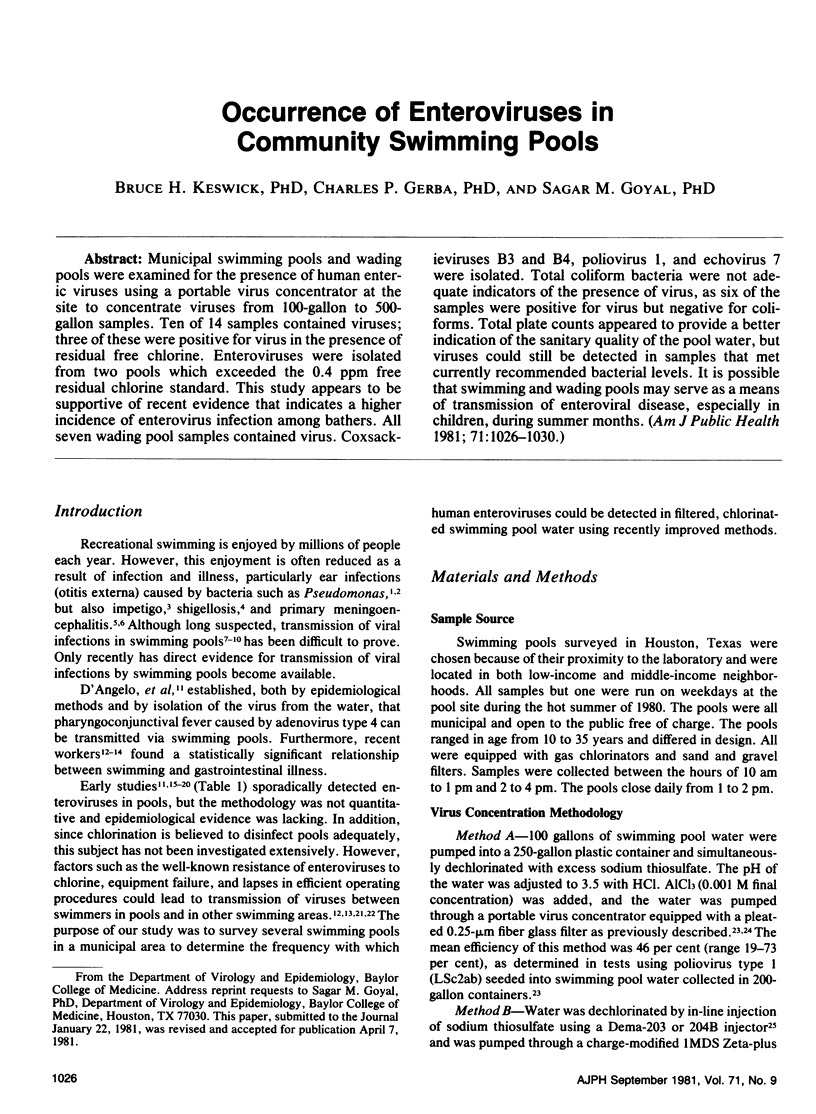
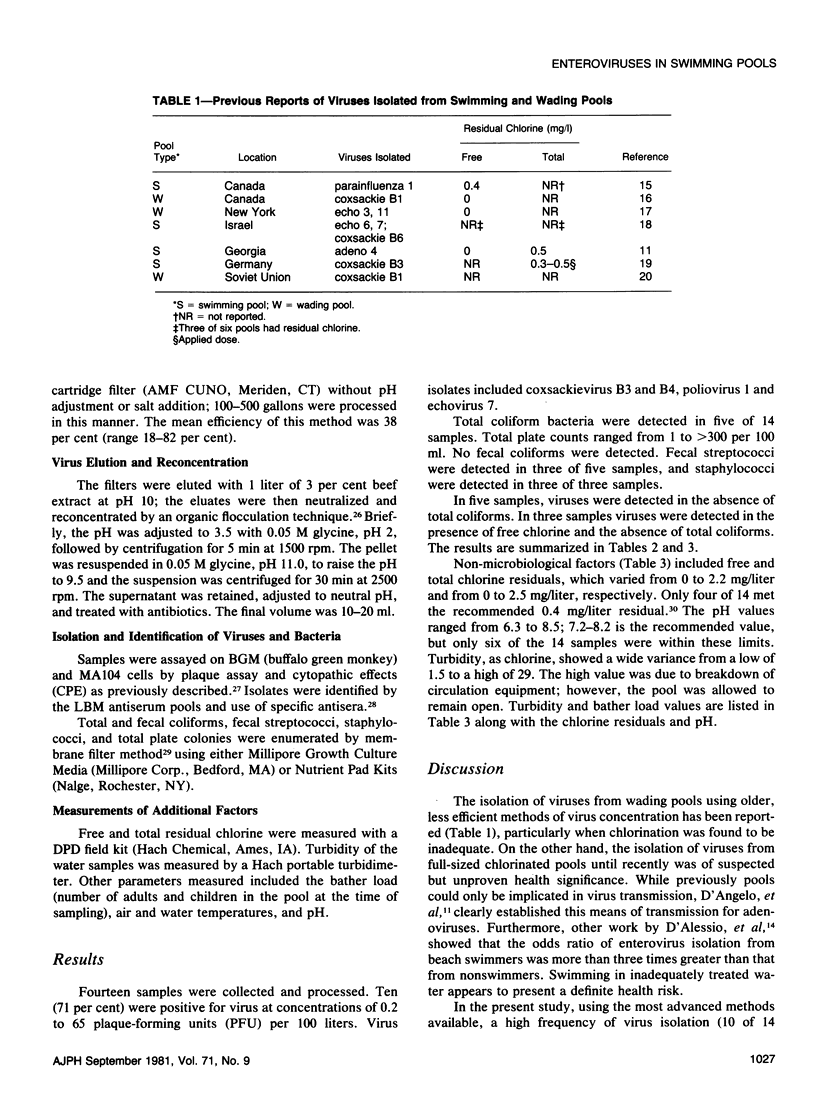
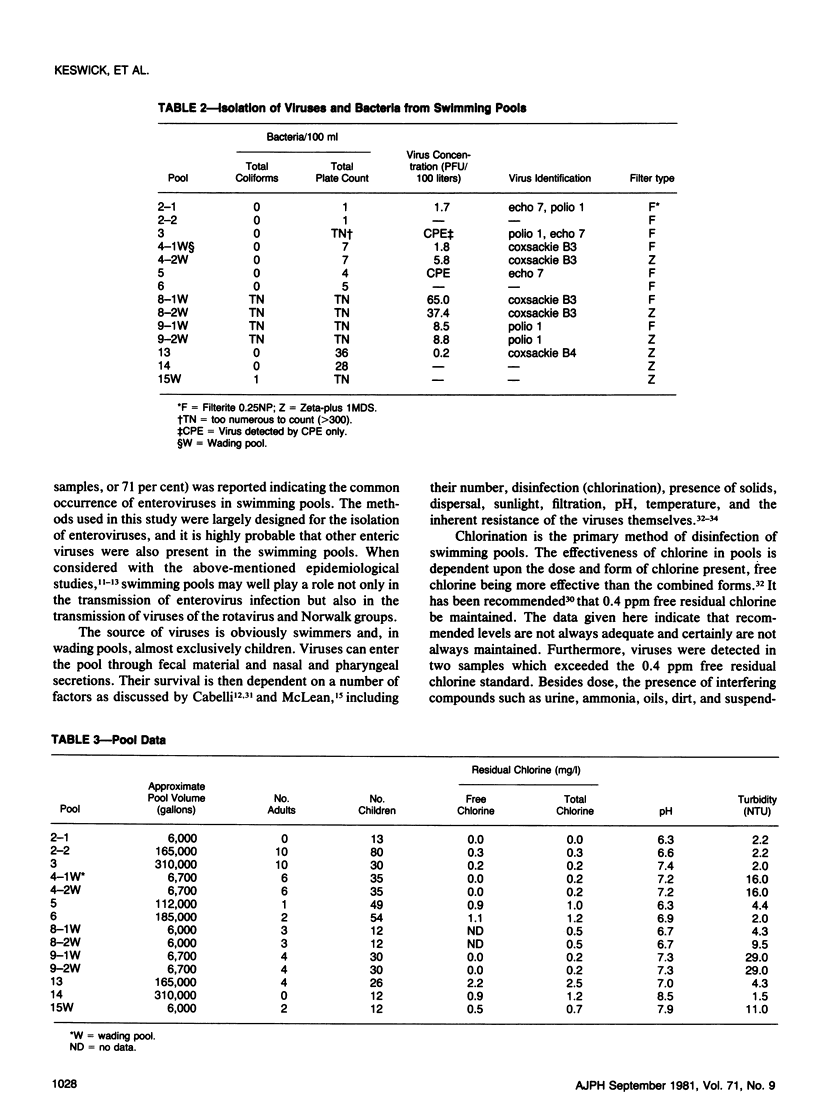
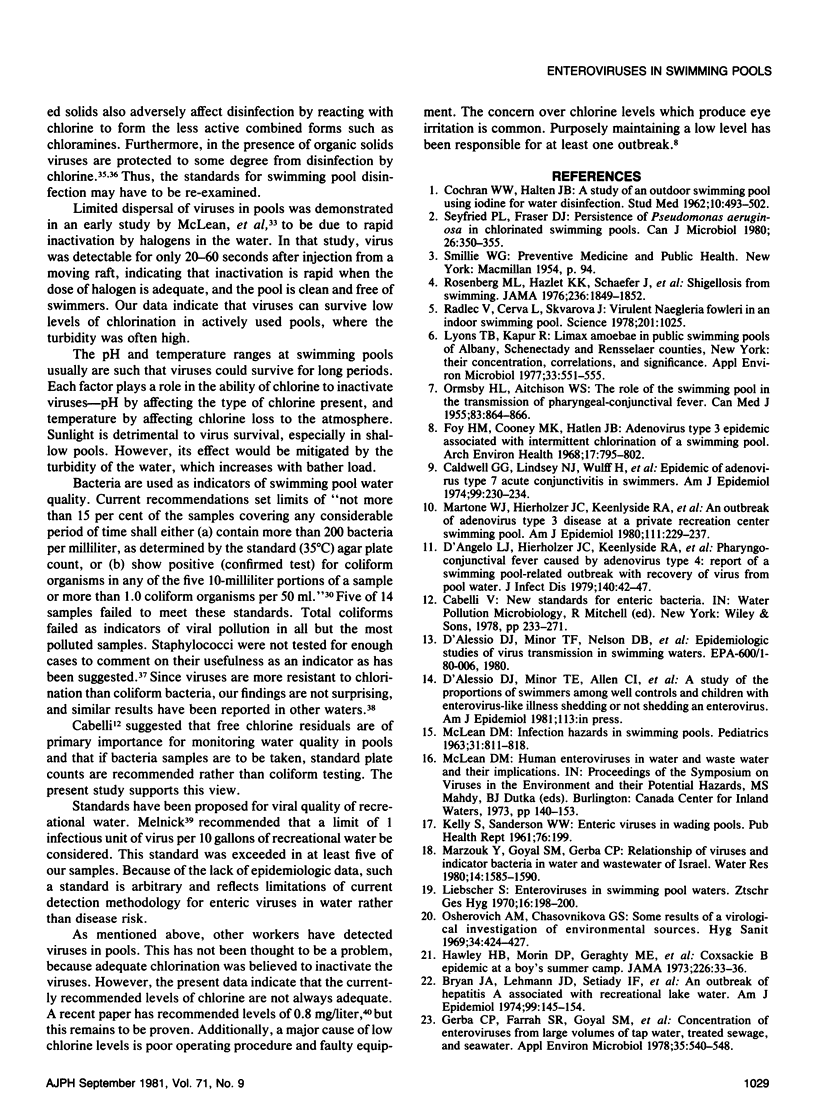
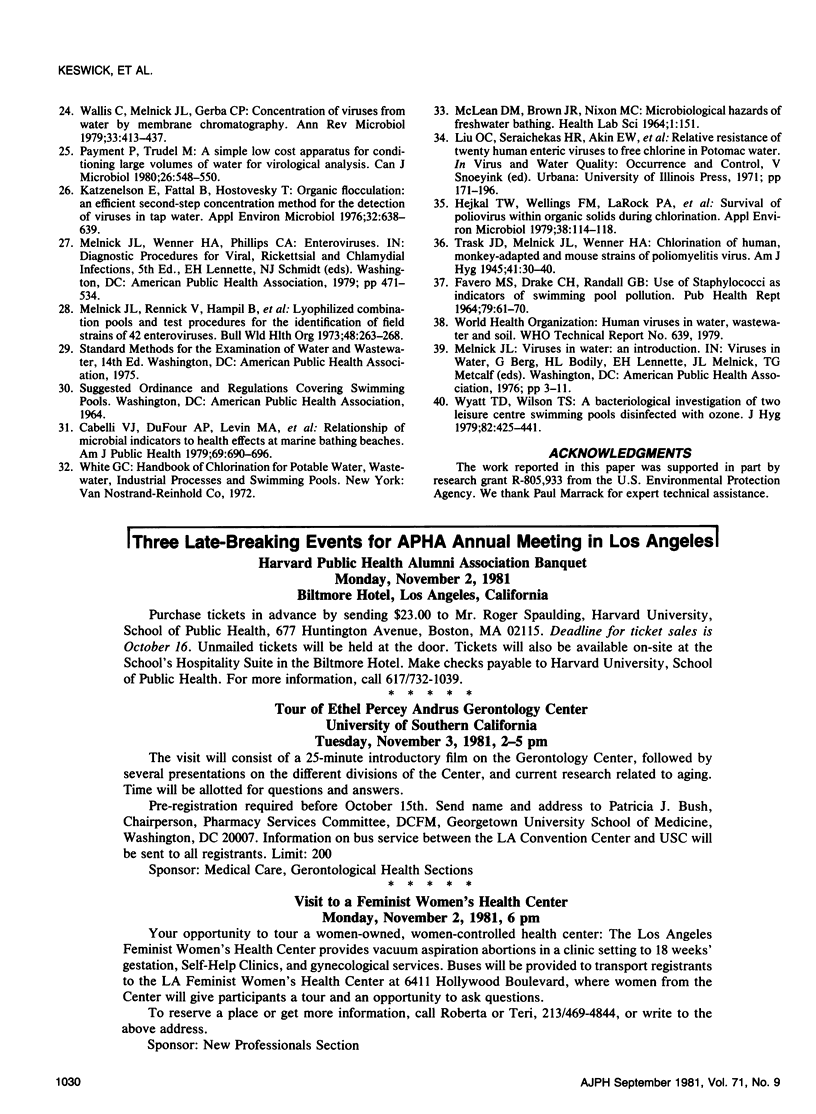
Selected References
These references are in PubMed. This may not be the complete list of references from this article.
- Bryan J. A., Lehmann J. D., Setiady I. F., Hatch M. H. An outbreak of hepatitis-A associated with recreational lake water. Am J Epidemiol. 1974 Feb;99(2):145–154. doi: 10.1093/oxfordjournals.aje.a121595. [DOI] [PubMed] [Google Scholar]
- COTHRAN W. W., HATLEN J. B. A study of an outdoor swimming pool using iodine for water disinfection. Studenterraad Med. 1962 Apr;10:493–502. [PubMed] [Google Scholar]
- Cabelli V. J., Dufour A. P., Levin M. A., McCabe L. J., Haberman P. W. Relationship of microbial indicators to health effects at marine bathing beaches. Am J Public Health. 1979 Jul;69(7):690–696. doi: 10.2105/ajph.69.7.690. [DOI] [PMC free article] [PubMed] [Google Scholar]
- Caldwell G. G., Lindsey N. J., Wulff H., Donnelly D. D., Bohl F. N. Epidemic of adenovirus type 7 acute conjunctivitis in swimmers. Am J Epidemiol. 1974 Mar;99(3):230–234. doi: 10.1093/oxfordjournals.aje.a121607. [DOI] [PubMed] [Google Scholar]
- D'Angelo L. J., Hierholzer J. C., Keenlyside R. A., Anderson L. J., Martone W. J. Pharyngoconjunctival fever caused by adenovirus type 4: report of a swimming pool-related outbreak with recovery of virus from pool water. J Infect Dis. 1979 Jul;140(1):42–47. doi: 10.1093/infdis/140.1.42. [DOI] [PubMed] [Google Scholar]
- FAVERO M. S., DRAKE C. H., RANDALL G. B. USE OF STAPHYLOCOCCI AS INDICATORS OF SWIMMING POOL POLLUTION. Public Health Rep. 1964 Jan;79:61–70. [PMC free article] [PubMed] [Google Scholar]
- Foy H. M., Cooney M. K., Hatlen J. B. Adenovirus type 3 epidemic associated with intermittent chlorination of a swimming pool. Arch Environ Health. 1968 Nov;17(5):795–802. doi: 10.1080/00039896.1968.10665321. [DOI] [PubMed] [Google Scholar]
- Gerba C. P., Farrah S. R., Goyal S. M., Wallis C., Melnick J. L. Concentration of enteroviruses from large volumes of tap water, treated sewage, and seawater. Appl Environ Microbiol. 1978 Mar;35(3):540–548. doi: 10.1128/aem.35.3.540-548.1978. [DOI] [PMC free article] [PubMed] [Google Scholar]
- Hawley H. B., Morin D. P., Geraghty M. E., Tomkow J., Phillips C. A. Coxsackievirus B epidemic at a Boy's Summer Camp. Isolation of virus from swimming water. JAMA. 1973 Oct 1;226(1):33–36. [PubMed] [Google Scholar]
- Hejkal T. W., Wellings F. M., LaRock P. A., Lewis A. L. Survival of poliovirus within organic solids during chlorination. Appl Environ Microbiol. 1979 Jul;38(1):114–118. doi: 10.1128/aem.38.1.114-118.1979. [DOI] [PMC free article] [PubMed] [Google Scholar]
- Kadlec V., Cerva L., Skvárová J. Virulent Naegleria fowleri in an indoor swimming pool. Science. 1978 Sep 15;201(4360):1025–1025. doi: 10.1126/science.684423. [DOI] [PubMed] [Google Scholar]
- Katzenelson E., Fattal B., Hostovesky T. Organic flocculation: an efficient second-step concentration method for the detection of viruses in tap water. Appl Environ Microbiol. 1976 Oct;32(4):638–639. doi: 10.1128/aem.32.4.638-639.1976. [DOI] [PMC free article] [PubMed] [Google Scholar]
- Liebscher S. Enteroviren im Schwimmbadwasser. Z Gesamte Hyg. 1970 Mar;16(3):198–200. [PubMed] [Google Scholar]
- Lyons T. B., Kapur R. Limax amoebae in public swimming pools of albany, schenectady, and rensselaer counties, new york: their concentration, correlations, and significance. Appl Environ Microbiol. 1977 Mar;33(3):551–555. doi: 10.1128/aem.33.3.551-555.1977. [DOI] [PMC free article] [PubMed] [Google Scholar]
- MCLEAN D. M. Infection hazards in swimming pools. Pediatrics. 1963 May;31:811–818. [PubMed] [Google Scholar]
- Martone W. J., Hierholzer J. C., Keenlyside R. A., Fraser D. W., D'Angelo L. J., Winkler W. G. An outbreak of adenovirus type 3 disease at a private recreation center swimming pool. Am J Epidemiol. 1980 Feb;111(2):229–237. doi: 10.1093/oxfordjournals.aje.a112890. [DOI] [PubMed] [Google Scholar]
- Melnick J. L., Rennick V., Hampil B., Schmidt N. J., Ho H. H. Lyophilized combination pools of enterovirus equine antisera: preparation and test procedures for the identification of field strains of 42 enteroviruses. Bull World Health Organ. 1973;48(3):263–268. [PMC free article] [PubMed] [Google Scholar]
- ORMSBY H. L., AITCHISON W. S. The role of the swimming pool in the transmission of pharyngeal-conjunctival fever. Can Med Assoc J. 1955 Dec 1;73(11):864–866. [PMC free article] [PubMed] [Google Scholar]
- Payment P., Trudel M. A simple low cost apparatus for conditioning large volumes of water for virological analysis. Can J Microbiol. 1980 Apr;26(4):548–550. doi: 10.1139/m80-094. [DOI] [PubMed] [Google Scholar]
- Rosenberg M. L., Hazlet K. K., Schaefer J., Wells J. G., Pruneda R. C. Shigellosis from swimming. JAMA. 1976 Oct 18;236(16):1849–1852. [PubMed] [Google Scholar]
- Seyfried P. L., Fraser D. J. Persistence of Pseudomonas aeruginosa in chlorinated swimming pools. Can J Microbiol. 1980 Mar;26(3):350–355. doi: 10.1139/m80-057. [DOI] [PubMed] [Google Scholar]
- Wallis C., Melnick J. L., Gerba C. P. Concentration of viruses from water by membrane chromatography. Annu Rev Microbiol. 1979;33:413–437. doi: 10.1146/annurev.mi.33.100179.002213. [DOI] [PubMed] [Google Scholar]
- Wyatt T. D., Wilson T. S. A bacteriological investigation of two leisure centre swimming pools disinfected with ozone. J Hyg (Lond) 1979 Jun;82(3):425–441. doi: 10.1017/s002217240005395x. [DOI] [PMC free article] [PubMed] [Google Scholar]


